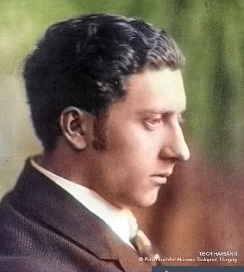
HARSÁNYI: 3 Pièces Lyriques. 3 Pièces de Danse. Suite Brève. Petite Suite de Danse. Étude. Rythmes, Cinq Inventions pour Piano. 12 Petites Pièces. Improvisation sur la Chanson “Je vais revoir ma Normandie.” 13 Dances: Fox-trot. Valse, Op. 2 / Giorgio Koukl, pno / Grand Piano GP807
Hungarian composer Tibor Harsányi (1898-1954), virtually forgotten in the West, is one of several pet projects of the great Czech pianist Giorgio Koukl, who for some reason flies a bit under the radar of most classical listeners. This is, perhaps, because most of the material he plays is off the radar of most pianists to begin with (Harsányi, Kapralova, Lourie—lots of Lourie, and Martinů), but he is clearly a major talent and needs to be recognized as such.
As in the case of Vol. 1 of this series, the titles of these works—“lyric pieces,” “dance pieces,” “little dance suite,” “little pieces”—belie the extraordinary invention and originality of the music. In fact, there’s probably a good chance that the harmonic and melodic complexity of these pieces, when heard in concerts, put many listeners off even during Harsányi’s lifetime. Like the “small” piano pieces of Erwin Schulhoff, the music is quite complex, requiring a sharply-honed musical mind to appreciate them. Even Beethoven’s bagatelles, most of which (“Für Elise” excepted) are amazingly well-written, are more audience-friendly than Harsányi’s constant shifting of meter and harmony.
 It’s not that his music is forbiddingly atonal…in fact, it’s not really atonal at all. It’s more that although he occasionally lands in tonal spaces, more often than not he is shifting the notes within chords and using what progressive jazz musicians of the 1950s and ‘60s called “rootless chords” to keep tonality slightly at bay. Moreover, he adds to this very strong rhythms, just as Bartók did, and unlike Bartók’s “Easy Pieces” and Mikrokosmos which are indeed audience-friendly, nothing Harsányi wrote can be said to fit into that category. Sometimes his music “climbs the scale” chromatically, or maintains a somewhat lyrical top line while the harmony continually clashes not only with that top line but also with the other chords surrounding it, and none of this, combined with his strong rhythms, provides any “comfort listening.”
It’s not that his music is forbiddingly atonal…in fact, it’s not really atonal at all. It’s more that although he occasionally lands in tonal spaces, more often than not he is shifting the notes within chords and using what progressive jazz musicians of the 1950s and ‘60s called “rootless chords” to keep tonality slightly at bay. Moreover, he adds to this very strong rhythms, just as Bartók did, and unlike Bartók’s “Easy Pieces” and Mikrokosmos which are indeed audience-friendly, nothing Harsányi wrote can be said to fit into that category. Sometimes his music “climbs the scale” chromatically, or maintains a somewhat lyrical top line while the harmony continually clashes not only with that top line but also with the other chords surrounding it, and none of this, combined with his strong rhythms, provides any “comfort listening.”
Even the first of his 3 Pièces de Danse, a tango, could never appeal to an Argentinean looking for sensual dance music, despite the fact that in this piece Harsányi’s harmony is not as spiky as it usually is. He uses close seconds in his chords that always seem to be clashing with each other and with the top line, a rhythmic but not terribly melodic theme seemingly comprised of mostly arpeggiated figures. And yes, of course we get another dance piece called a “Boston,” which I’d love someone to explain to me since American dance music of the 1920s had no such thing, though Eastern European composers all seemed to think so. (Yes, I have researched this online, and no folks, there wasn’t any such dance as a “Boston.”) Here, too, Harsányi indulges in some very strange harmony, a bit less spiky than the “Bostons” of Schulhoff but abrasive nonetheless. But if you thought these are strange, wait until you hear his “Mouvement de Fox Trot,” which is sort of a ragtime piece from the Twilight Zone, using both chromatics and whole-tone harmonies in a fashion that is truly bizarre.
The fox trot that opens the Suite Brève is rather more conventional, using open fourths and fifths to produce almost an American folk song sound, presaging Aaron Copland by nearly a decade. The “Andante” in this suite is also rather tame for Harsányi, but the “Presto” is a sort of bitonal perpetuum mobile of rapid eighths that one could not dance to unless one were a centipede on uppers. “Mouvement de blue” is a bit of an enigma, in which Harsányi combines the American blues form with both Hungarian and modern classical harmonies that alternate, while the concluding “Vivace” doesn’t really seem to be a “dance” piece at all. And the whole of this suite takes a mere eight minutes!
Although bitonal harmonies are also used in the 1924 Petite Suite de Danse, this is some of Harsányi’s most attractive and least complex music, except for the third piece, titled “Démence,” with its jagged rhythms and strange harmonies. The last piece in this suite, titled “Fête,” sounds very Debussy-ish, but like Debussy hopped up on cocaine, with much stronger rhythms and a louder volume level. The second piece in his Rythmes, the “Allegretto scherzando,” is another attractive and relatively uncomplicated piece, and the following “Allegretto ma non troppo” is not far behind, but with the “Allegretto ritmato” Harsányi again plunges us into exotic and somewhat abrasive harmonic territory.
One could give just as detailed descriptions of every piece in this recital, of which only the 3 Pièces de Danse are not first recordings. Harsányi may yet have a long way to go before he begins to show up on pianists’ concert programs, but at least we can appreciate what he had to offer on Koukl’s remarkable recordings.
—© 2020 Lynn René Bayley
Follow me on Twitter (@Artmusiclounge) or Facebook (as Monique Musique)
